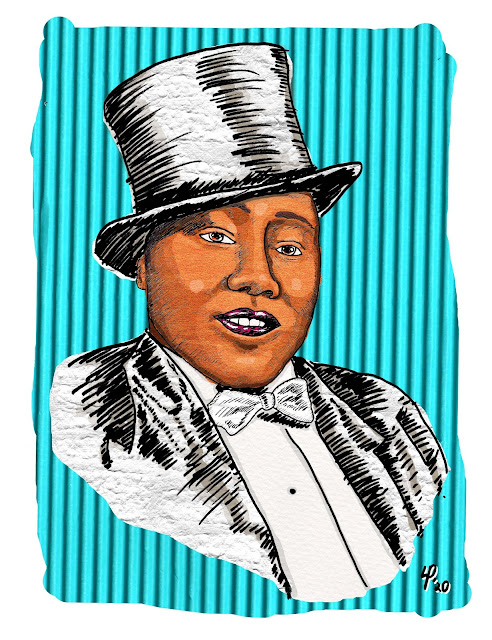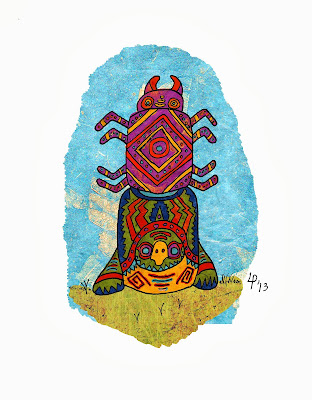Voices of Color: Gladys Bentley, the Most Famous Lesbian of Harlem
"Some of us wear the symbols and badges of our non-conformity"
-Gladys Bentley/Bobbie Minton
As Pride month is wrapping up, we look at the life and work of Gladys Bentley. Gladys was "gender-bending" long before the days of Stonewall, or the Pop icons from the 60s, 70s, and 80s that we know so well; like Grace Jones, David Bowie, Annie Lennox, Boy George or even Prince. Bentley was carving out a grand canyon of gender non-conformity long before any of those other legends, so to speak, stood within it. She was a force of nature within the Harlem Renaissance, pushing the absolute limits of the times. Her performances framed her legend and carved her face into the Rushmore of queer history forever.
This week, we honor the Voice of Gladys Bentley, the most famous lesbian of the Harlem Renaissance.
Bentley's story begins very sadly, in Philadelphia. She was the firstborn to a mother who so desperately wanted a son that she rejected her daughter. Bentley's grandmother was made to care for her for the first 6 months of her life. It was this maternal rejection that Bentley attributes the beginning of the journey into reexamining what gender is and what gender meant to her. In an interview, she had said, "It seems I was born different. At least, I always thought I was." Bentley began defying societal notions of femininity and feminine behaviors. She preferred her brother's suits to her own dresses or blouses. She preferred the company of women to men and formed crushes on her female school teachers.
Because of her appearance and behavior, she was teased by her peers, rejected by her family and sent to doctors and psychiatrists in order to "fix" her. if the mental and emotional abuse she endured from her family wasn't enough, conversion therapy certainly would have done her in completely. Gladys ran away from home at the age of 16, and like so many queers and misfits that came before her and followed after her, she escaped to New York City.
She answered a want-ad for a male pianist at Harlem's Clam House, NYC's (then) most notorious gay speakeasy. She began performing in all-male attire under her stage name Barbara "Bobbie" Minton. Dressed to the nines in white full dress shirts, stiff collars, small bow ties, oxfords, short Eton jackets, and hair cut straight back, Bobbie would unexpectedly bring down the house. She would continue to bring it down every night after.
"The boss was reluctant to give me a chance,” Bentley wrote.
“I finally convinced him. My hands fairly flew over the keys.
When I had finished my first number, the burst of applause was terrific.”
Bentley's vocal stylings were deep and booming with an occasional growling effect and imitations of a horn. She sang loud and she sang crass. She became famous for her risque performances that were often parodies of well-known blues songs changing the lyrics to the song to make it about sexual relationships or innuendos about her own homosexuality. She was well known for flirting with the women in the audience. She was also well known for "clashing" musical culture by "applying sexually charged 'black' blues demur" to "romantic 'white' ballads." Bentley was known for mocking the high-class image with the low-class humor. Audiences in the Harlem Speakeasies couldn't get enough of her. She was quite a sensational spectacle. She even took the performance from the stage out into the real world via sensational gossip papers. She created quite the editorial scandal after, in an interview, she laid claim to having married a white woman from Jersey.
When Bentley decided it was time to move her one-woman show to Broadway, like you do, this began the decline of her famous career. The police came to shut down and quit literally lock up the club she was playing. The shift in location also became a shift in the audience. Bentley's gender-bending thrills did not amuse or entice. It scandalized and ended with the police being called to shut the performance down.
"I am a woman again."
The end of the Prohibition Era was really the last nail in the coffin of her career in New York City. Bentley moved to California where she continued to perform under such racially charged billing as "America's Greatest Sepia Piano Player" and the "Brown Bomber of Sophisticated Songs." Try as she might have, she never gained back quite the success she had gained in Harlem. By the time of the McCarthy Era of the 1950s, Bentley had rebranded her bold, brass, and gender-bending image to a much more conservative palatable one. She wore dresses and even went away to be "cured" of her homosexuality. She declared in an essay she had written, "I am a woman again." Upon her return, she married and a man named Charles Roberts, but it was a marriage for show only. Roberts later denied ever marrying Bentley. Bentley died of pneumonia in 1960 at the age of 52. It is tragically sad that in Bentley's final years she had to again pretend to be someone that she was not just to survive; a sentiment that echos in the hearts, minds, and tears of queer people and people of color for years to come afterward.
Like so many figures in the history of gay, queer and transgendered people, the story of Gladys Bentley is bookended by such sorrow, rejection, and intolerance. Though, her legacy shines brightly, boldly, and brassily in between them. It is too bad that she did not live to see what she both inspired and trailblazed for. She will be forever remembered for her contributions to the gay community and to the arts. Her spirit, I'm sure, smiles down from the stars that hang musically over the silhouette of Harlem.
Happy Pride, Everyone.
Until next time, friends,
Keep dreaming, keep sketching, keep thinking, keep laughing, and most important of all, keep making art.
Cheers,
LEWIS







Comments
Post a Comment